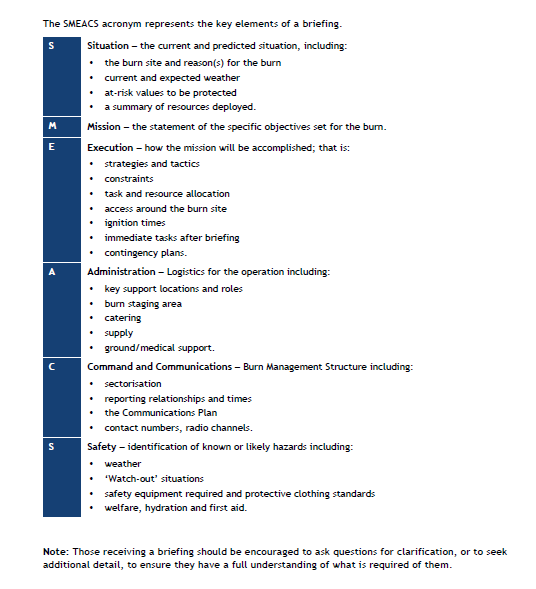Module Objective: To know the important aspects to include when briefing personnel prior to a prescribed burn.
The aim of a briefing is to ensure that all personnel are adequately prepared to undertake their role in the burn and understand the wider objectives and plan for the burn. By providing key information about the conditions and operating environment they are being asked to work in, everyone is aware of the situation they will be facing, how this may change throughout the burn, and what actions they can take to keep themselves and others safe.
Briefings should be undertaken on the morning of the burn, and each member of the team needs to be briefed and a check made before light up that they feel adequately informed and confident to carry out their role in the burn. Effective briefings help to reduce uncertainty and promote co-ordination amongst the team. The aim of a briefing helps ensure:
[Could note here a case study about landowners who have been prosecuted due to inadequate briefing or using those personnel not adequately equipped or trained for the task]
Before the burn is started the entire crew should be told how the burn is to be carried out: the lighting pattern, individual responsibilities and duties, the probable hazard areas, the expected fire behaviour given the weather and fuels present, and the sequence of events to undertake to achieve the burn objectives.
Plan the briefing
Conduct the briefing
Activity: Identify the roles for the crew required for your prescribed burn. What specific briefings will each crew member require? What communication protocols will you need and how will you brief the crew on these?
Know why it is important to perform a briefing prior to burning, and how to brief personnel involved in a prescribed burn.
Review the burn plan and make sure everyone understands it.
Make crew assignments.
Review the weather forecast.
Communications
Operations

The rule for the buddy system is that you work as a pair – entering, working and leaving the fire ground together. The purpose of the buddy system is that you look out for one another, maintain contact all the time and if that contact is lost, the buddy must take immediate action to re-establish contact, provide assistance or call for help.
Be aware of the location of your safety zone and ensure they have two options for an escape route to the safety zone. Where possible all personnel should walk or drive the safety zones and escape routes to familiarise themselves.
It’s essential to communicate any changes to the fire to all personnel on site to ensure safety of the resources and surrounding public and to be able to respond to break-outs or spot fires from outside the burn perimeter. Check that your communications equipment is working correctly.
Before entering the fire ground ensure you are wearing all your personal safety equipment and that you have adequate drinking water. Do NOT let anyone participate without appropriate personal safety equipment.
Don’t tuck clothing in, create layers so hot material you come into contact with doesn’t catch in your clothing. For example, don’t tuck the bottom of trousers into socks, let the trouser leg fall over the outside of your boot. When working close to the fire, use heavy leather gloves to protect your hands from radiant heat and hot material.
Make sure you get a full briefing.
Remember to ask questions if things are not clear to you.
Fire intensity increases abruptly when two fires burn together, and the increase is greater when fires converge along a line rather than at a point.
It takes a disciplined ignition crew to recognise that some ignition patterns require considerable patience and that it’s wiser not to force the fire but allow it to develop and achieve the fire behaviour sought for the burn.
Keep a close eye on the fire and alert your crew leader to any changes or unexpected fire behaviour.
Successful management of a heading fire requires that no individual strip of fire can develop to a high intensity before it reaches either a firebreak or another burned out strip.
Be aware that a large number of small fires burning simultaneously can produce the same kind of explosive convective energy as a single large fire because too much heat energy is released too rapidly.
When working around fire never underestimate the effects of radiant heat. The damaging effect of heat on your body builds up with the more time spent working in the heat.
Know your dangerous situation watch outs (see below) and LACES.